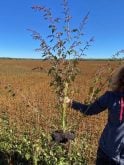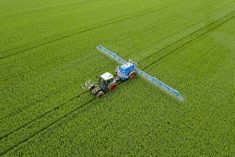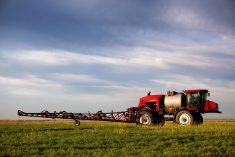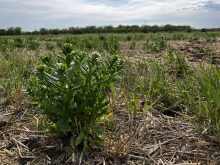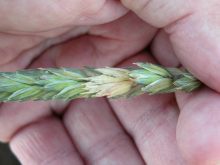There haven’t been many dicamba drift complaints in Canada since Monsanto commercialized dicamba-resistant soybeans in 2016.
In 2019 Health Canada received just “16 reports of dicamba-related environment incidents in Canada related to drift and over-the-top application of dicamba to soybean,” a Health Canada official wrote in an email June 10.
Health Canada, which regulates pesticides in Canada through the Pest Management Regulatory Agency (PMRA), recorded just two incidents of dicamba drift in Manitoba in 2017 and 2018 involving five sites, an official wrote in an email Aug. 31, 2018.
“Overall, Health Canada has received 18 incident reports, involving 35 sites, related to dicamba drift in Canada, the majority of which were in Ontario,” the email states. “Health Canada is monitoring the situation and will take action as necessary.”
Read Also

Manitoba sclerotinia picture mixed for 2025
Variations in weather and crop development in this year’s Manitoba canola fields make blanket sclerotinia outlooks hard to pin down
Bayer, which bought Monsanto, says the number of dicamba drift cases it has received continues to decline dropping to eight in 2019 from 18 in 2016.
“Roundup Ready Xtend Crop system acres (dicamba- and glyphosate-tolerant soybeans) increased from a few thousand seed-production acres to almost two million acres in 2019,” Bayer spokesperson Komie Hossini wrote in an email June 10.
“We encourage anyone experiencing issues related to dicamba off-target movement to contact us at 1-888-283-6847. Based on the inquiries we have received to date, we are pleased with the stewardship and proper use shown by farmers using the Roundup Ready Xtend Crop system and believe the vast majority of growers and applicators using XtendiMax have had great success with on-target applications.”
The climate and how dicamba is used in Canada account for why there are so few drift issues here compared to the United States, say several experts, including Tom Wolf, a partner in Agrimextrix, a Saskatoon-based company specializing in agricultural sprays, said in an interview June 16.
Canada, and especially Manitoba, which accounts for most of the soybeans grown in Western Canada, is much cooler than much of the U.S. so volatilization is less common.
“The people using the Xtend system here are using it more in a pre-emergent scenario than in a post-emergent scenario just for (drift) risk mitigation,” Manitoba Agriculture and Resource Development weed specialist Tammy Jones said in an interview June 9. “A lot of sensitive crops are not emerged at that point in time.”
It’s also cooler so it’s less likely the dicamba will vaporize, Wolf said.
“In Missouri and Arkansas they’d have a flush of these (glyphosate-resistant) weeds in June and July so they would still need to spray then because they’ll set seed a few weeks after emergence,” he said.
“The point is because of their weed spectra they spray more than once and much later in the season and therefore they meet both the heat and the increased susceptibility of (dicamba-susceptible) soybeans in the later growth stage. Soybeans become more susceptible as they leave the vegetative state and go into the reproductive stage. It’s a perfect storm really.”
American farmers face a lot more different weeds, including many that are glyphosate resistant and that leaves them no choice but to use dicamba or not grow certain crops, he said.
In Manitoba so far kochia is the only glyphosate-resistant weed and there are other herbicide options, Jones said.
“That means we don’t have to rely on the Xtend system as much,” she said.
“Unless you have very small kochia you’re not going to use the Xtend system anyway. If it’s glyphosate-resistant kochia and you are relying on the dicamba alone you want it nice and small when it’s easier to kill and that is early on. So the target weeds and the crops we are using it for it all sets us up for the most part for success rather than failure because we’ve only had that one weed.”
Meanwhile, PMRA is monitoring dicamba issues in the U.S. Jan. 30 it started a special review of dicamba products applied in crop when the plants start emerging and when they are actively growing, typically from late June to early August
“This special review focuses on the potential risks to non-target terrestrial plants from the use of over-the-top dicamba products,” Health Canada wrote in an email.
The products being studied are as follows: BASF — Banvel II Herbicide (originally CLARITY) and Engenia; Monsanto (now Bayer) — M1691 Herbicide, XtendiMax with VaporGrip Technology and Roundup Xtend with VaporGrip Technology Herbicide.








